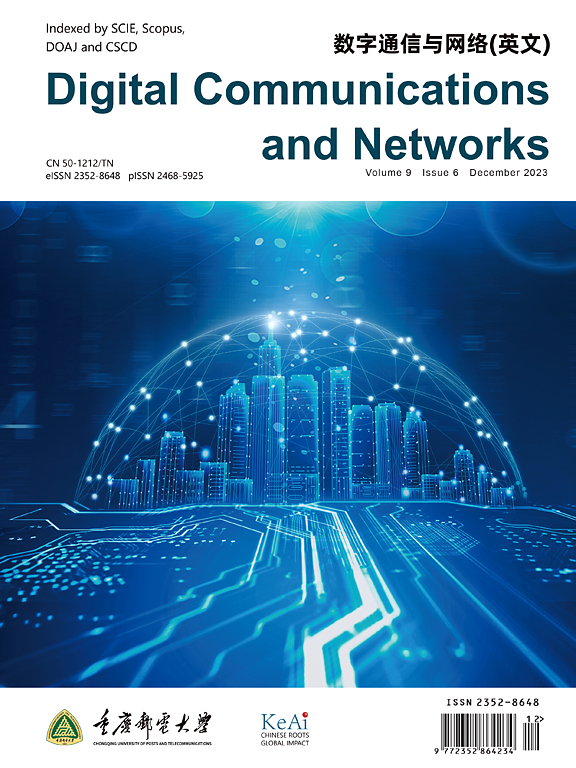一种基于深度学习的MAC,用于集成信道访问、速率自适应和信道切换
IF 7.5
2区 计算机科学
Q1 TELECOMMUNICATIONS
引用次数: 0
摘要
随着非授权无线网络的密度和异构性的增加,传统的MAC协议,如Wi-Fi网络中的载波感知避碰多址(CSMA/CA),正在经历性能下降。这表现在碰撞增加和后退时间延长,导致频谱效率和协议协调降低。为了解决这些问题,本文提出了一种基于深度学习的MAC范式,称为DL-MAC,它利用无线设备中能量检测模块中现成的频谱数据来实现信道接入、速率适应和信道切换的MAC功能。首先,我们利用DL-MAC实现信道接入和速率自适应的联合设计。随后,我们将通道切换功能集成到DL-MAC中,增强了其从单通道到多通道操作的功能。具体来说,DL-MAC协议结合了用于信道选择的深度神经网络(DNN)和用于信道接入和速率自适应联合设计的循环神经网络(RNN)。我们在2.4 GHz频段内进行了实际数据收集,以验证DL-MAC的有效性。实验结果表明,与传统算法相比,DL-MAC在单通道和多通道环境下都表现出显著的性能优势,并且优于单功能设计。此外,DL-MAC的性能保持稳健,在评估范围内不受信道交换开销的影响。本文章由计算机程序翻译,如有差异,请以英文原文为准。
A deep-learning-based MAC for integrating channel access, rate adaptation, and channel switch
With increasing density and heterogeneity in unlicensed wireless networks, traditional MAC protocols, such as Carrier Sense Multiple Access with Collision Avoidance (CSMA/CA) in Wi-Fi networks, are experiencing performance degradation. This is manifested in increased collisions and extended backoff times, leading to diminished spectrum efficiency and protocol coordination. Addressing these issues, this paper proposes a deep-learning-based MAC paradigm, dubbed DL-MAC, which leverages spectrum data readily available from energy detection modules in wireless devices to achieve the MAC functionalities of channel access, rate adaptation, and channel switch. First, we utilize DL-MAC to realize a joint design of channel access and rate adaptation. Subsequently, we integrate the capability of channel switching into DL-MAC, enhancing its functionality from single-channel to multi-channel operations. Specifically, the DL-MAC protocol incorporates a Deep Neural Network (DNN) for channel selection and a Recurrent Neural Network (RNN) for the joint design of channel access and rate adaptation. We conducted real-world data collection within the 2.4 GHz frequency band to validate the effectiveness of DL-MAC. Experimental results demonstrate that DL-MAC exhibits significantly superior performance compared to traditional algorithms in both single and multi-channel environments, and also outperforms single-function designs. Additionally, the performance of DL-MAC remains robust, unaffected by channel switch overheads within the evaluation range.
求助全文
通过发布文献求助,成功后即可免费获取论文全文。
去求助
来源期刊

Digital Communications and Networks
Computer Science-Hardware and Architecture
CiteScore
12.80
自引率
5.10%
发文量
915
审稿时长
30 weeks
期刊介绍:
Digital Communications and Networks is a prestigious journal that emphasizes on communication systems and networks. We publish only top-notch original articles and authoritative reviews, which undergo rigorous peer-review. We are proud to announce that all our articles are fully Open Access and can be accessed on ScienceDirect. Our journal is recognized and indexed by eminent databases such as the Science Citation Index Expanded (SCIE) and Scopus.
In addition to regular articles, we may also consider exceptional conference papers that have been significantly expanded. Furthermore, we periodically release special issues that focus on specific aspects of the field.
In conclusion, Digital Communications and Networks is a leading journal that guarantees exceptional quality and accessibility for researchers and scholars in the field of communication systems and networks.
 求助内容:
求助内容: 应助结果提醒方式:
应助结果提醒方式:


